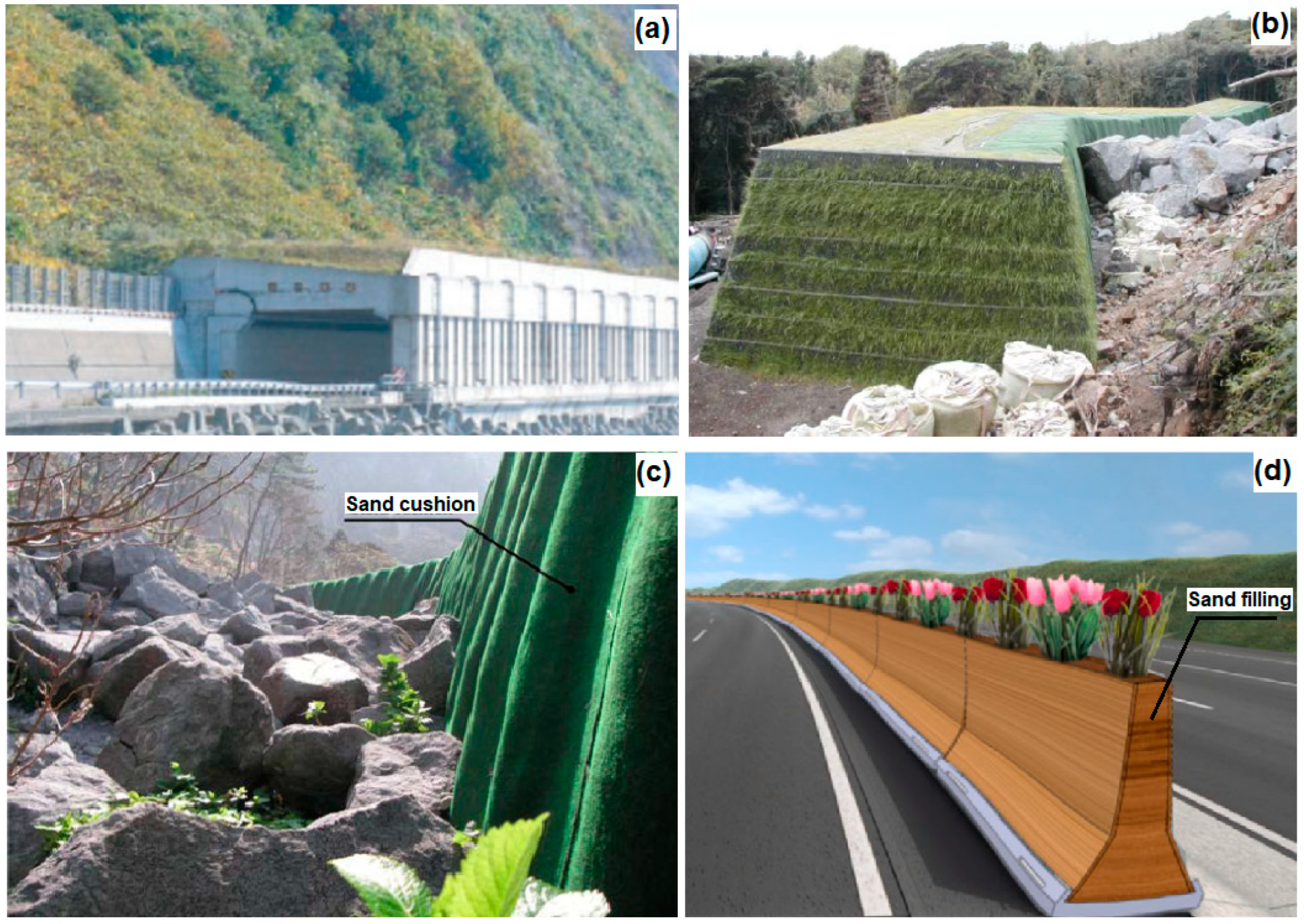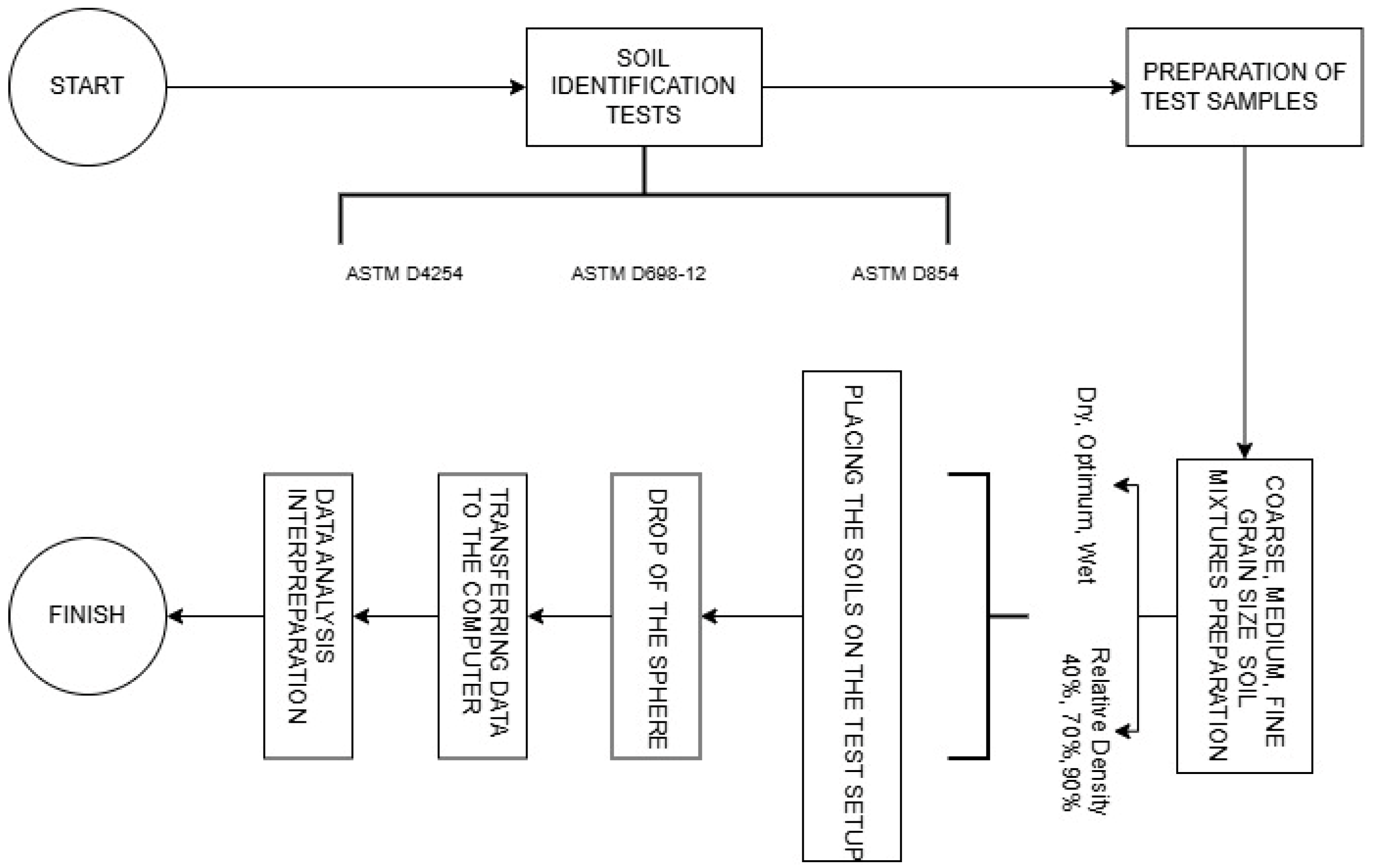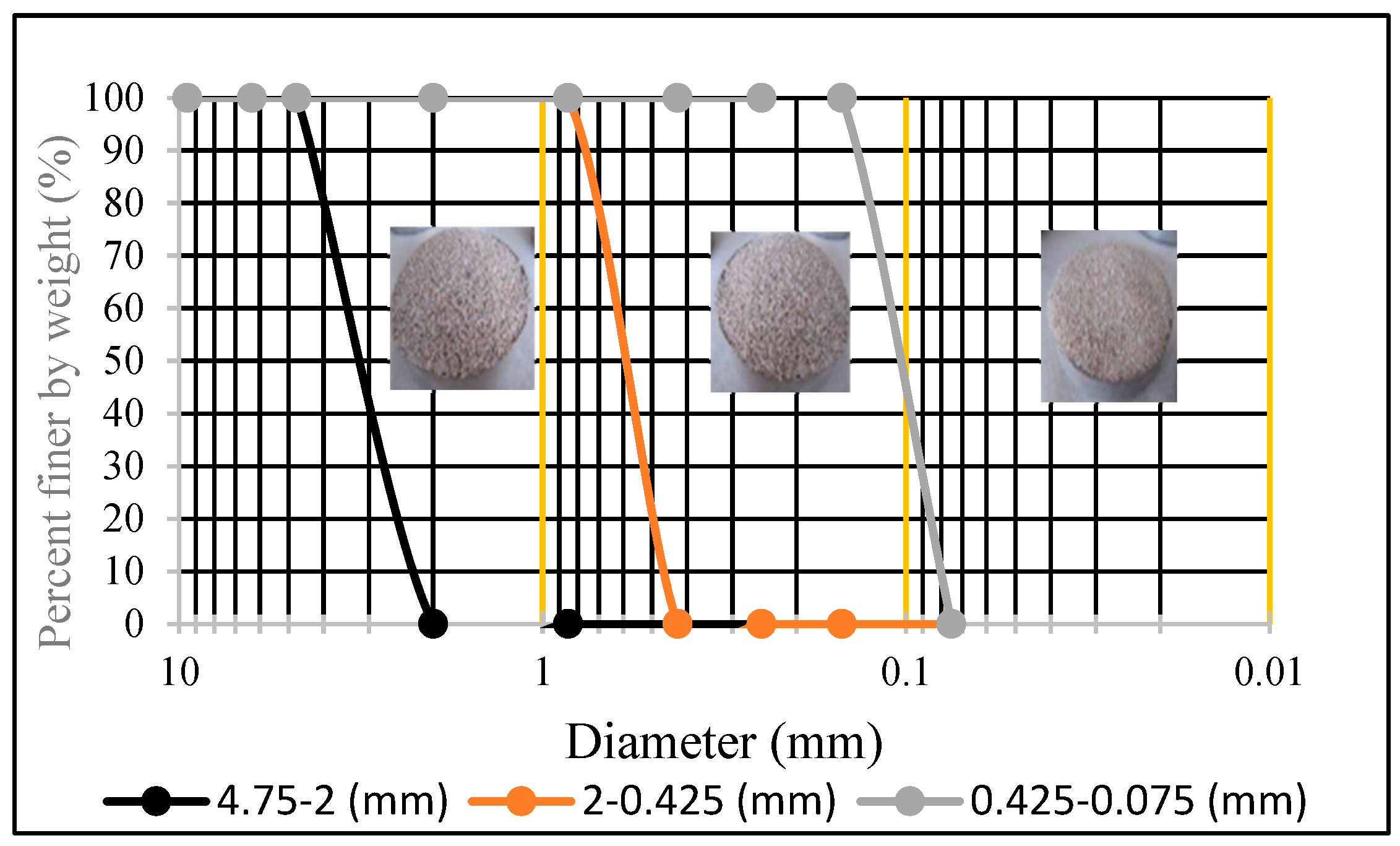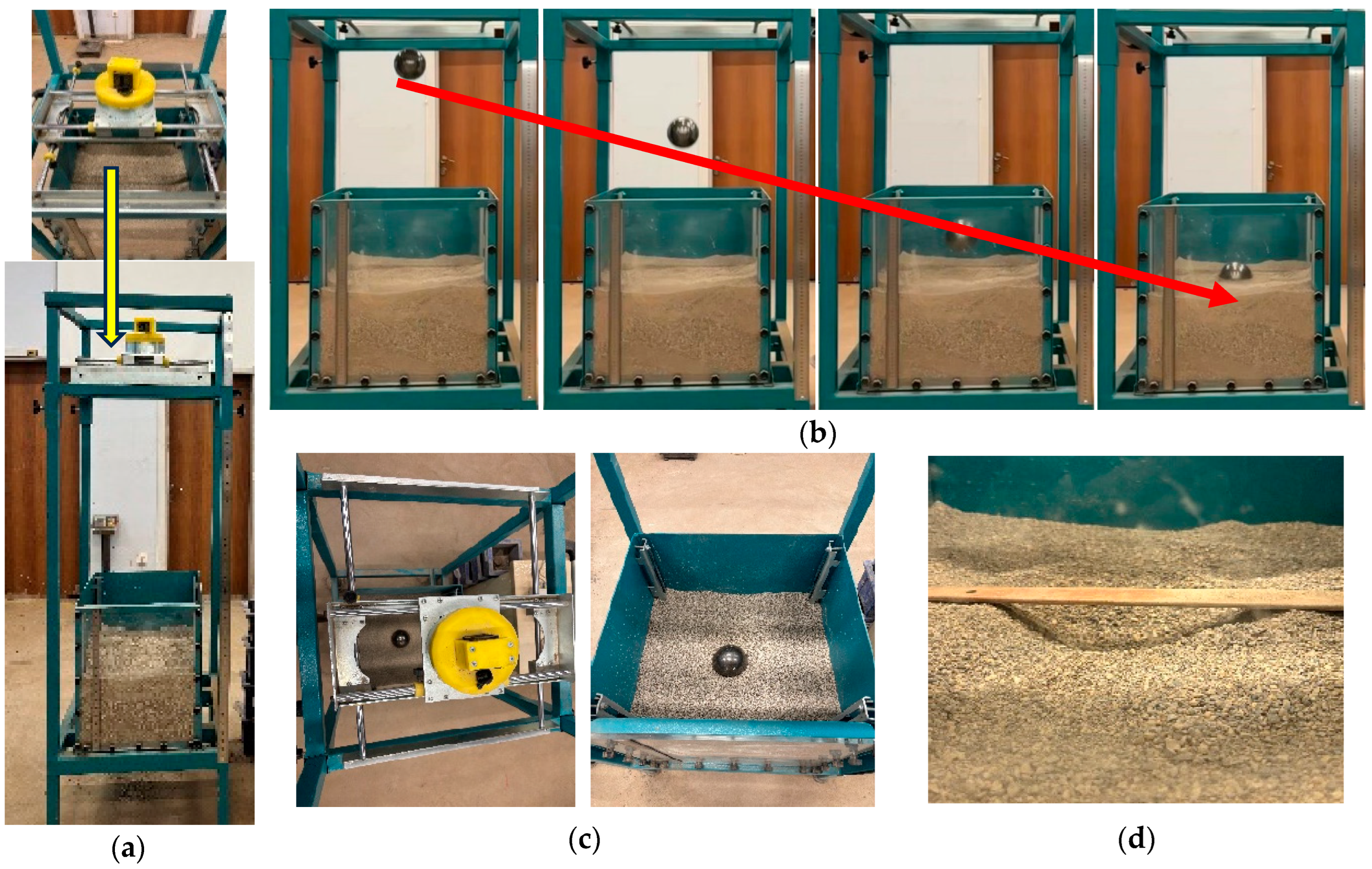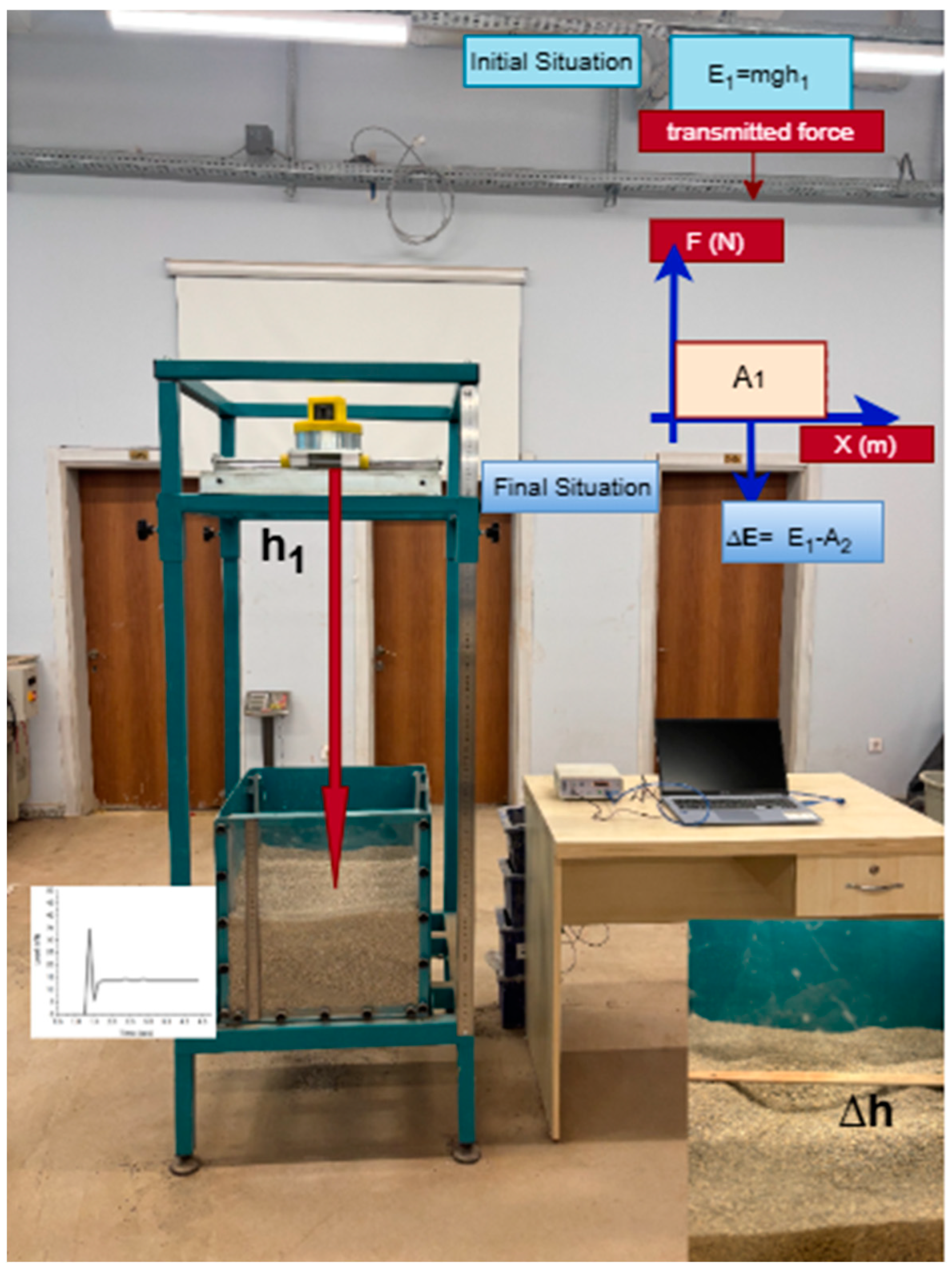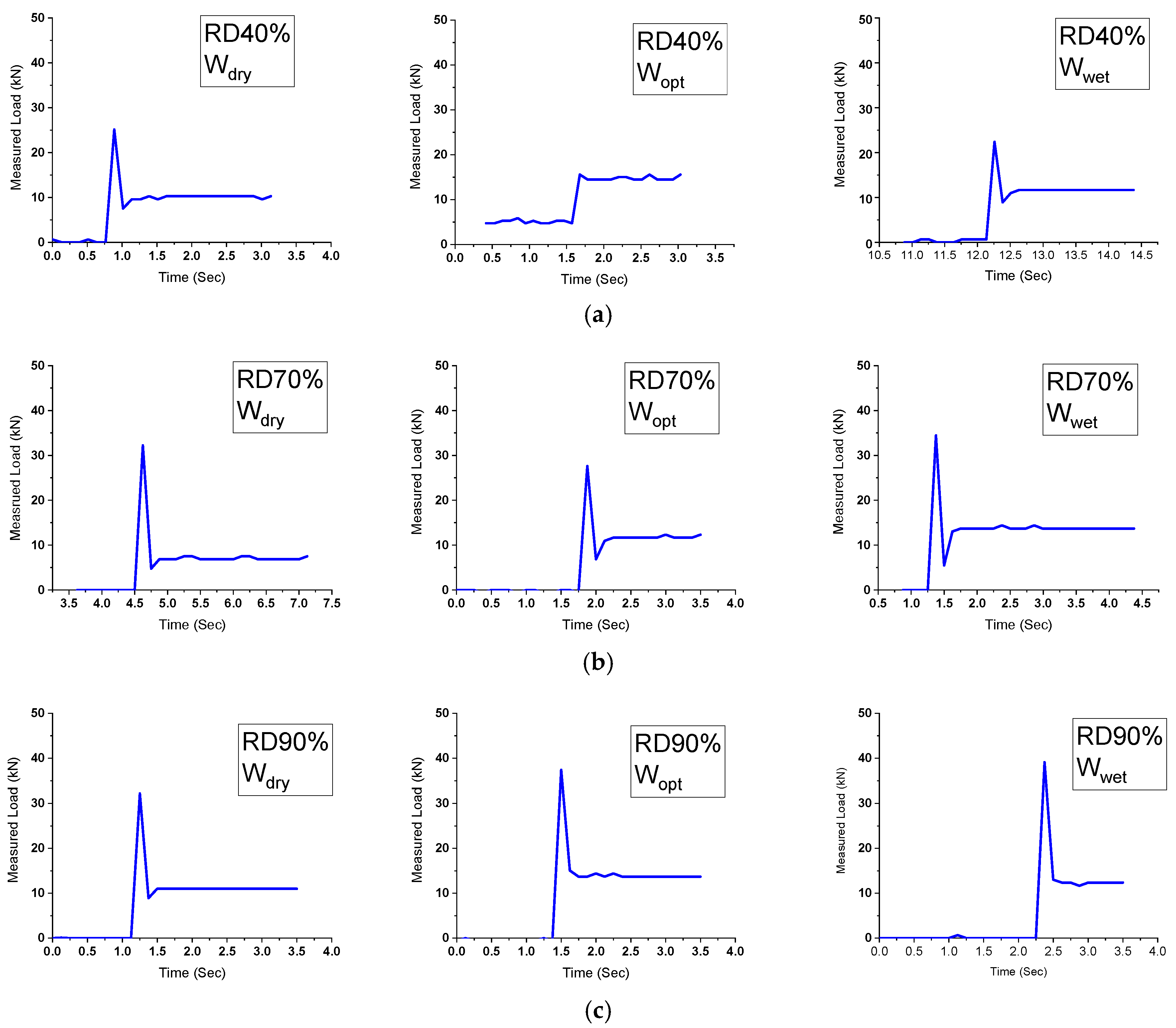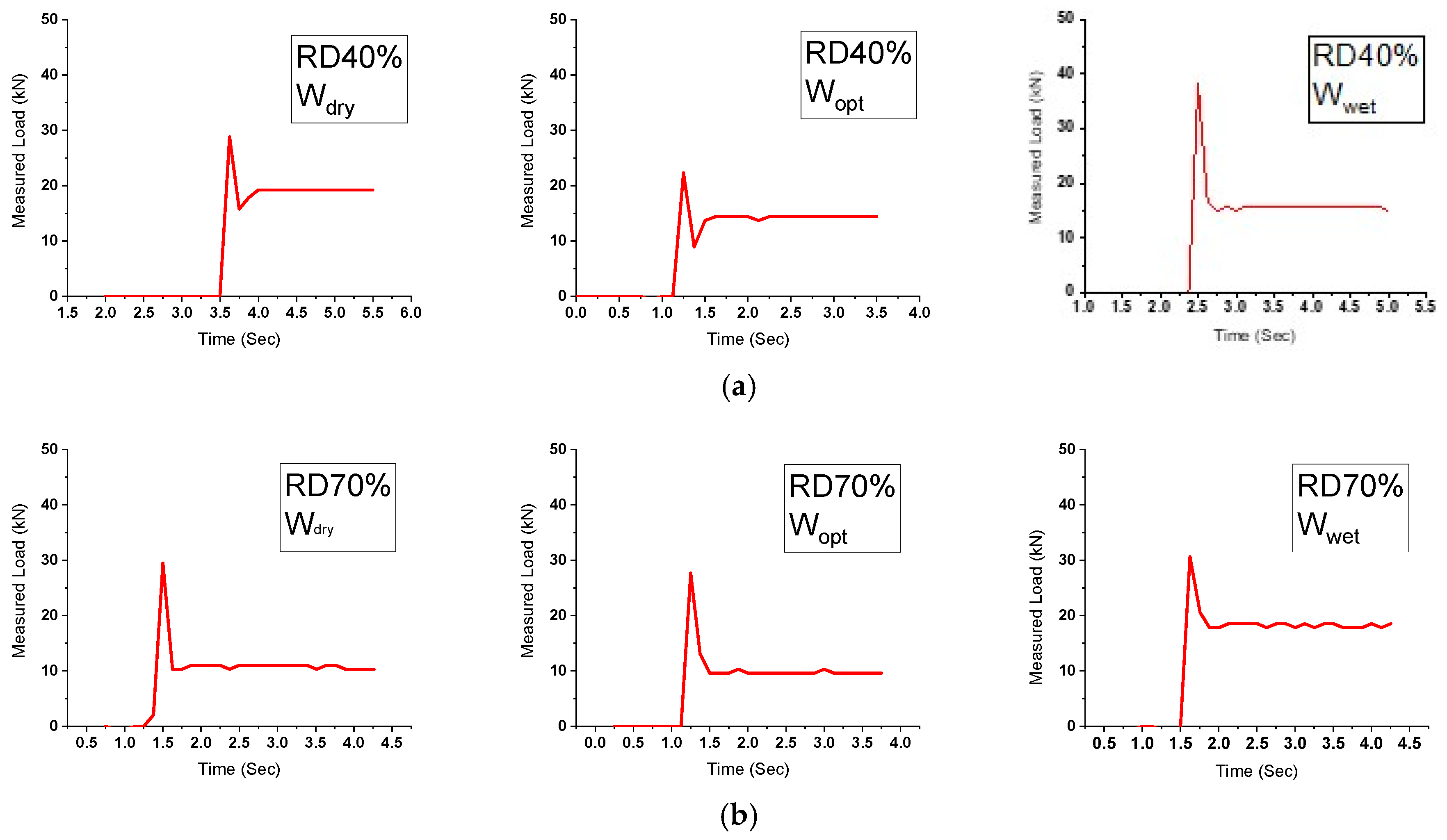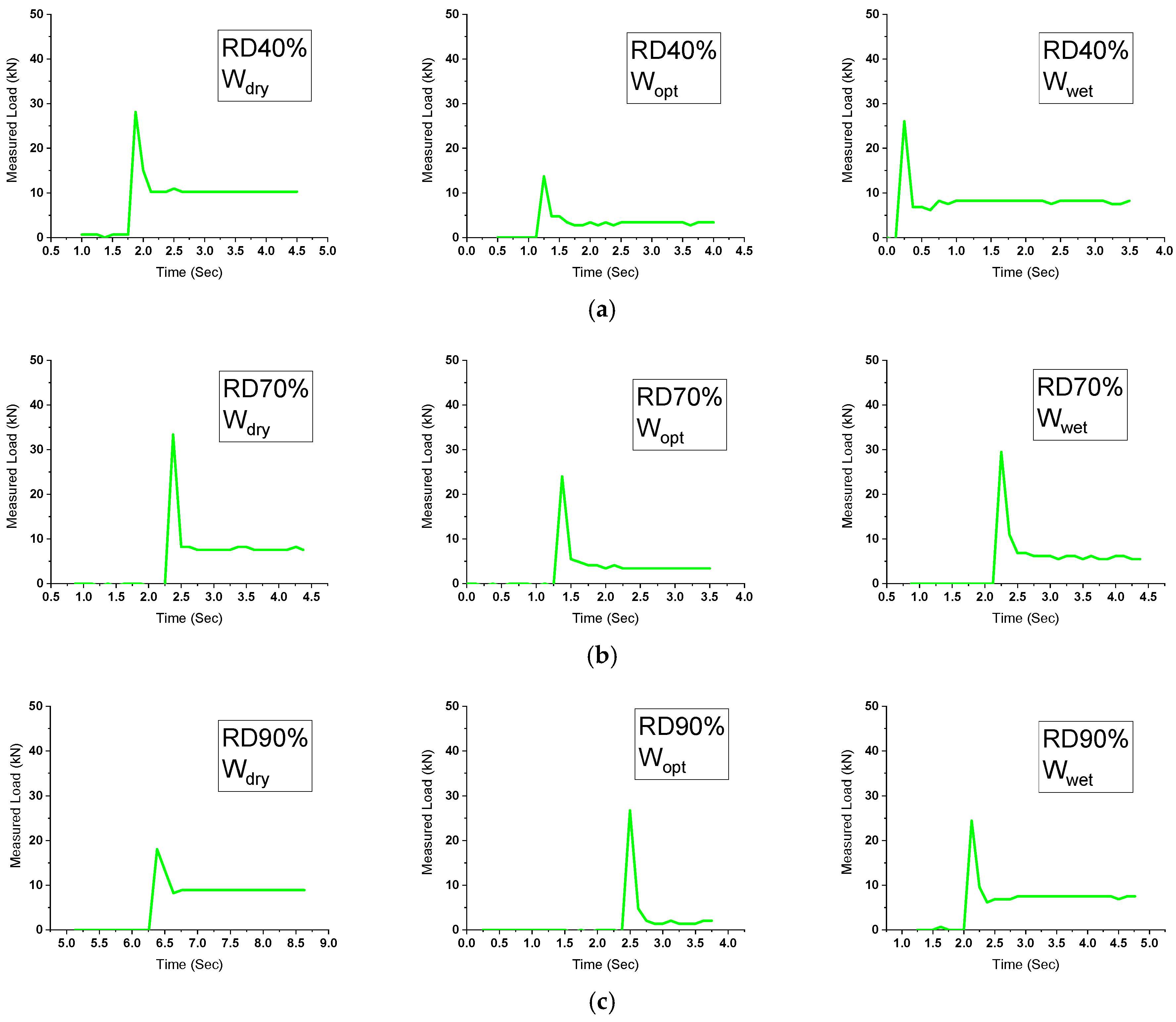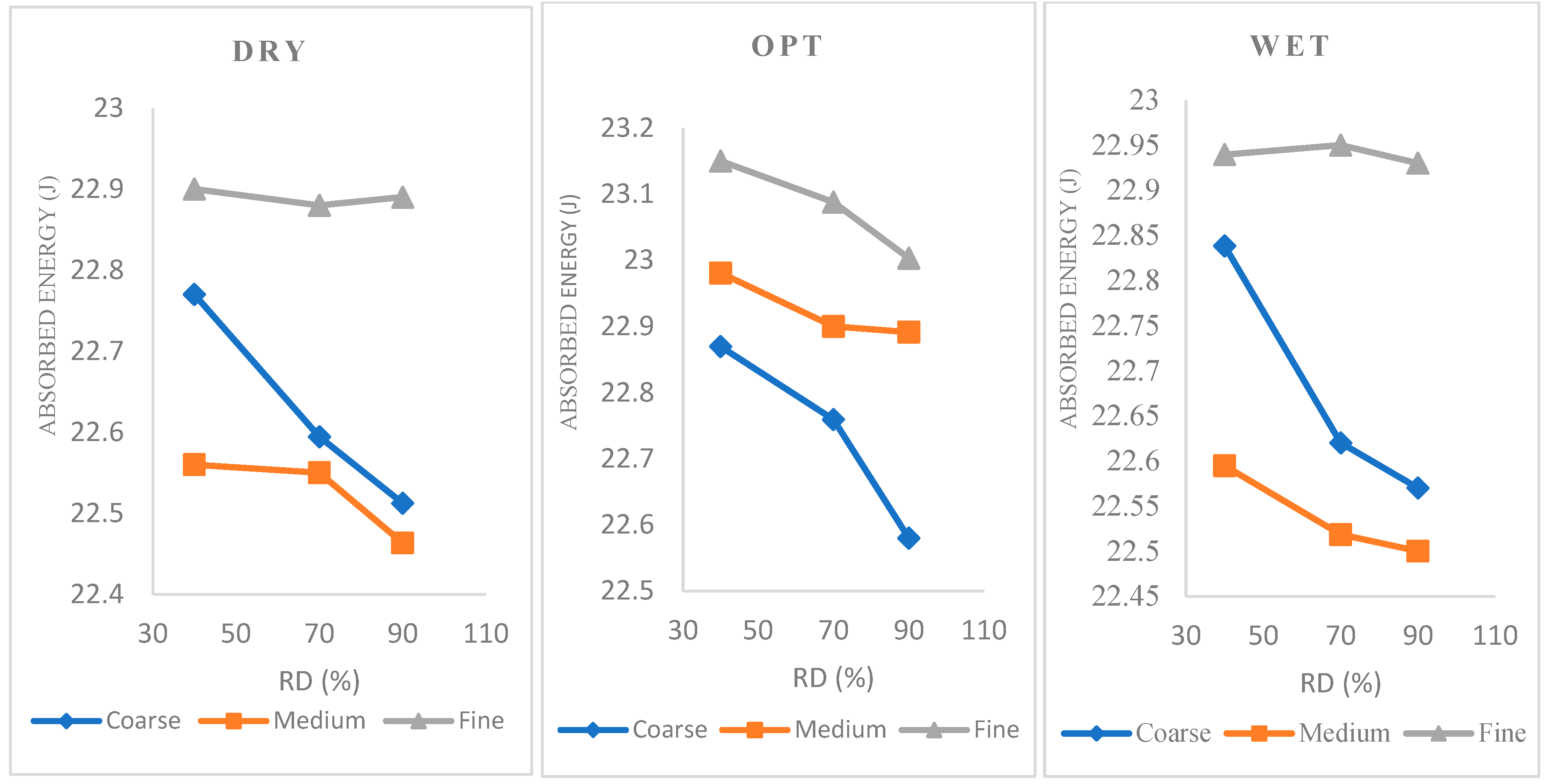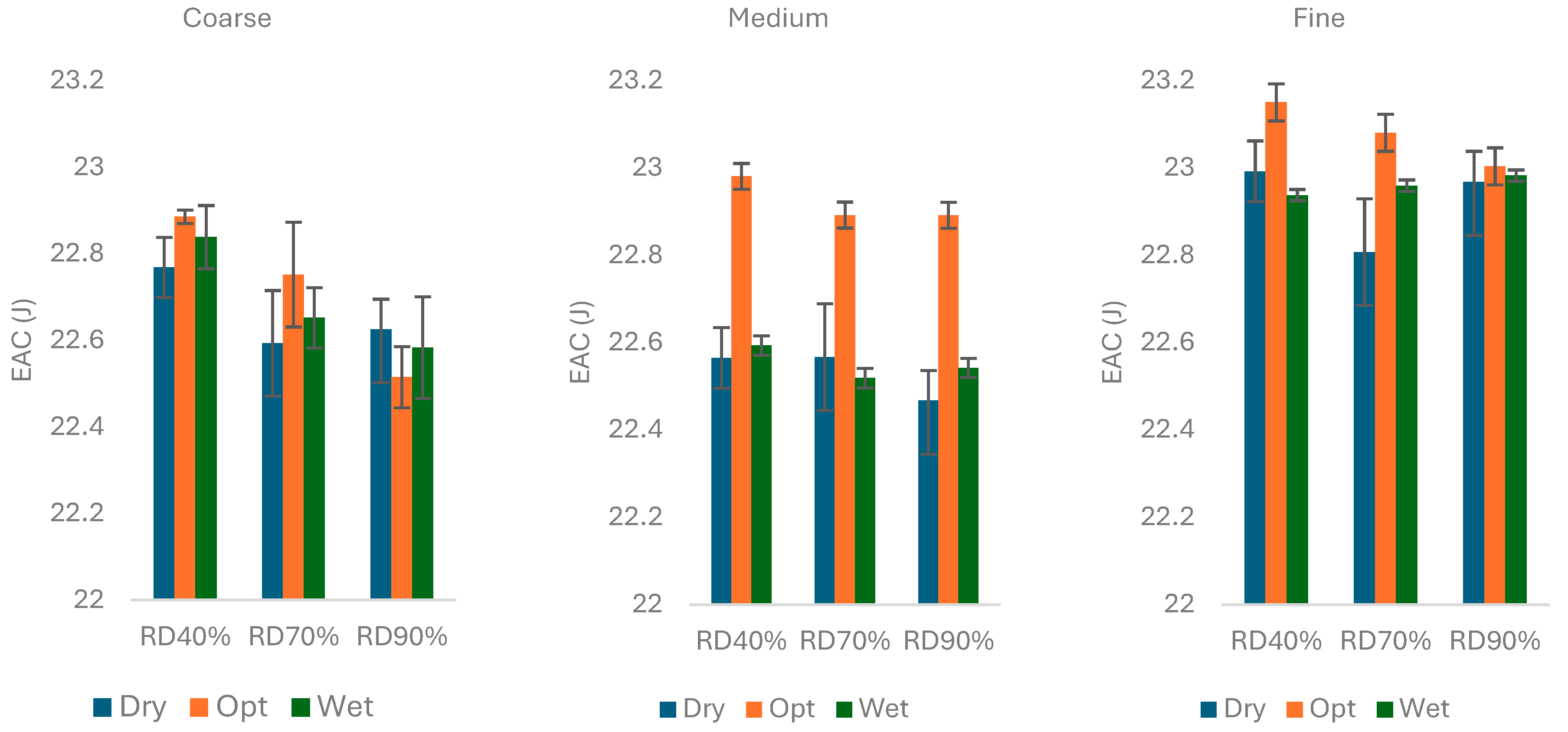1. Introduction
In geotechnical engineering, soil behavior is typically investigated under static and dynamic loading conditions [
1]. The response of soils to static and cyclic loads such as those induced by superstructures, hydrostatic forces, and repeated mechanical stress has been one of the central topics in geotechnical research [
2,
3]. The main differences between static and dynamic loads include factors such as inertia effects, damping, strain-rate sensitivity, and oscillatory response. Dynamic soil behavior, particularly in the context of earthquake loading and soil–structure interaction, has been extensively explored in previous studies [
4,
5,
6]. However, the behavior of soils under sudden, short-duration, and high-intensity impact loads remains relatively under-investigated. Impact events, including falling rocks, projectile strikes, and blast loads, cause rapid stress transitions and demand significant energy dissipation within the soil matrix. Understanding this behavior is essential for the development of protective, energy-absorbing geotechnical systems.
A substantial body of experimental and numerical research has investigated the role of sand-based systems in mitigating impact forces, particularly within protective structures such as rock sheds, pipelines, foundation systems, and roadside barriers. Watanabe et al. [
7] simulated rockfall impacts on sand cushions using the Distinct Element Method and emphasized the effects of sand grain size, randomness, and cushion thickness on energy dissipation efficiency. However, their study remained limited to load transmission, without directly quantifying the energy absorbed by the soil mass itself. Sy Ho and Masuya [
8] utilized LS-DYNA to analyze sand-filled geocells under rockfall loading, validating their numerical model with full-scale tests, yet their focus was on the structural performance of the geocell container rather than intrinsic soil behavior. Abdel-Malek et al. [
9] examined sand compaction under high-pressure, high-strain-rate loading, revealing that moisture content and particle size substantially affect stress distribution and deformation behavior. Though their drop-weight tests reached up to 2000 MPa, the experimental design was geared toward material characterization for mine-blast conditions rather than soil system energy absorption. Bhatti [
10] evaluated sand cushion performance in reinforced concrete rock-shed galleries via finite element simulations, reporting increased flexibility and impact resistance at structural edges. However, the energy dissipation was inferred from structural deformation, not from soil mechanics directly.
Yuan et al. [
11] conducted lab-scale drop weight experiments to assess how falling object shape, mass, and drop height influence impact force, affirming that sand cushions significantly reduce peak stress. Nevertheless, their study addressed performance metrics such as force attenuation, not actual absorbed energy. Ryu et al. [
12] focused on the dynamic response of seabed soil under submarine pipeline impact, while Pan [
13] investigated sand layers for seismic isolation beneath shallow foundations—both of which contribute valuable insights but do not target high-rate vertical impacts like free-falling bodies. Chian et al. [
14] tested the ballistic resistance of sand blocks with varying densities under projectile impacts and found that higher density improved energy absorption. Yet, their emphasis was on penetration resistance, not soil deformation or energy quantification. Kabala and Śledziński [
15] proposed viscoelastic rubber layers (like neoprene) for repeatable laboratory testing, but their material differs fundamentally from granular soils in both structure and energy dissipation behavior. Finally, Yumrutaş et al. [
16] used a sand–wood hybrid barrier in roadside barriers, validating their design through EN-1317-compliant impact testing, yet the combined barrier system complicates isolation of soil-specific absorption performance (
Figure 1).
In contrast to these studies, which focus primarily on structure-level responses or composite buffering systems, the present work introduces a standardized laboratory methodology that enables the direct measurement of impact energy absorption by sandy soils under controlled loading conditions. By employing a custom-built apparatus capable of capturing load–time data during vertical impact events, this study investigates how grain size, moisture content, and relative density affect energy dissipation in dry and saturated sandy soils. In doing so, it addresses a key gap in current geotechnical research and contributes toward developing performance-based criteria for soil-involved protective systems.
Discussions on how energy resulting from impact is absorbed by soils are still limited in the literature, and no standardized test procedure has been widely accepted. While previous studies [
8,
16] investigated energy dissipation in protective systems using sand or composite materials, they often lacked direct measurements of soil response or focused on non-granular media. Moreover, existing studies rarely provided a systematic evaluation of how grain size, moisture content, and relative density affect energy absorption under impact loads [
17]. Thus, there remains a gap in systematically quantifying the energy absorption capacity (EAC) of soils under controlled dynamic loading conditions [
18,
19,
20,
21]. This study addresses that gap by introducing a custom-designed experimental setup and testing protocol to directly evaluate the EAC of sandy soils with varying physical characteristics. This methodology enables quantification of the effects of soil parameters on impact response and provides a foundation for future performance-based design in geotechnical applications.
Recent advancements in geotechnical engineering have increasingly focused on enhancing the energy absorption capacity (EAC) of soils under impact loads, particularly for applications in infrastructure protection. Bayoumy et al. [
17] and Moslemi et al. [
22] have investigated the role of fiber-reinforced soils, demonstrating that the inclusion of sustainable natural fibers in clayey sands significantly improves both mechanical performance and resistance to dynamic loading. These studies suggest that fiber reinforcement can effectively increase a soil’s ability to dissipate impact energy, making such improved materials suitable for protective structures including retaining walls, embankments, and energy-absorbing barriers. While these contributions are valuable, they predominantly emphasize additive-based improvements and do not comprehensively examine how inherent physical properties of soils such as grain size distribution, moisture content, and relative density influence their dynamic response. In contrast, the present study introduces a novel experimental setup and standardized methodology to directly and quantitatively assess the EAC of sandy soils under controlled impact loading conditions. By focusing on intrinsic parameters rather than external reinforcements, this research addresses a critical gap in the literature and provides insights that are directly applicable to performance-based geotechnical design.
Recent studies have increasingly focused on enhancing the energy absorption behavior of sands under dynamic and impact loading conditions by modifying either the material composition or testing methodology. For example, Li et al. [
23] employed a Split Hopkinson Pressure Bar to examine the dynamic compressive behavior of sand under passive confining pressure, demonstrating that moisture content and relative density significantly influence energy dissipation and particle breakage under high strain rates. Similarly, Yu et al. [
24] conducted comparative high strain-rate tests on coral and silica sands, highlighting how particle size and relative density govern energy absorption capacity, with coral sand exhibiting superior compressibility and impact resistance due to its porous structure. These findings support our emphasis on physical parameters such as grain size and compaction levels in energy absorption evaluations. Moreover, studies incorporating sand-based composite systems have offered complementary insights. Nong et al. [
25] examined stress transmission in sand–tire mixtures under impact loads and found that tire inclusion notably reduced vertical stress transfer, underscoring the role of grain structure and density in impact mitigation. Additionally, Doddamani et al. [
26] investigated the vulcanization of rubber–sand composites, where the synergistic effect of sand particles and elastic matrices enhanced both hardness and energy dissipation under impact, though the focus remained on engineered materials rather than soil properties per se. A similar trend was reported by Thakur et al. [
27], who studied ballistic protection composites incorporating sand inclusions in polymer matrices, further affirming the granular medium’s potential for dissipating high-intensity loads.
In contrast to these works that either modify the soil composition or embed sand in synthetic matrices, the current study contributes a novel experimental framework that focuses purely on the physical characteristics of sandy soils, namely, particle size, relative density, and moisture content under free-fall impact loads. By introducing a custom-designed drop-weight apparatus and a standardized testing method, this research offers a new approach for directly quantifying the energy absorption capacity of soils without chemical or structural modification. This distinguishes our study within the evolving landscape of geotechnical impact research and responds to the evident need for repeatable, parameter-specific investigations in soil dynamics.
Sandy soils are naturally capable of dissipating impact energy due to their granular structure, making them suitable for use in protective geotechnical applications such as retaining walls, rockfall galleries, escape ramps, and underground pipeline casings [
28,
29,
30]. Compacted sands tend to dilate under shear loads, allowing particles to rearrange and spread the impact force across a wider area [
31,
32]. Unlike solid materials that deform plastically, sand grains hinder penetration and distribute point loads effectively, which enhances their energy absorption capability [
33,
34]. Several recent studies have explored the use of sand cushions in practical systems to mitigate impact loads. For example, sand beds have been used in rockfall protection tunnels to absorb falling debris and reduce transmitted stresses [
29]. Similarly, hybrid barriers composed of sand-wood materials demonstrated higher energy absorption than conventional metal guardrails [
16,
35,
36]. In seismic isolation, sand cushions placed beneath foundations have been shown to reduce the amplification of ground shaking [
13,
37]. In underground structures such as tunnels, transportation shafts, and defense facilities, sand layers are used to absorb shock loads caused by traffic, explosions, and construction activities [
38,
39].
The main objective of this study is to develop a new experimental setup that allows precise assessment of the impact energy absorption capacity of sandy soils. This study introduces the first experimental device specifically designed for this purpose, which allows controlled impact loading tests under varying ground conditions. It aims to fill an important gap, which is largely missing in the literature, by providing a methodological framework for direct and repeatable measurement of energy absorption in soils. The findings of the study and the proposed test method contribute to the preliminary determination of the energy absorption capacity of soil materials to be used in protective geotechnical structures such as retaining walls, rockfall barriers, and buried infrastructures. The developed experimental setup is designed by taking inspiration from pendulum impact systems and vertical loading principles used for different purposes in the literature. The test procedure is based on obtaining pressure-time data generated by a known mass dropped from a certain height hitting the ground surface. This methodology not only facilitates the evaluation of the energy dissipation behavior of sandy soils in a laboratory environment but also provides the necessary engineering data to characterize the behavior of such soils under impact loading.
2. Experimental Study
2.1. Experimental Material and Sample Preparation
Sandy soils have high energy absorption capacity due to their physical properties. In this study, the energy absorption behavior of sandy soils under impact loads was investigated in a laboratory environment.
Figure 2 illustrates a schematic flow chart summarizing the sequence of experimental procedures, from sample classification and preparation to data acquisition and interpretation. This visual representation supports the clarity and reproducibility of the developed methodology. The energy absorption capacity of the samples was analyzed with a specially developed impact load test. In order to ensure consistency in the experiments, all samples were meticulously prepared considering their physical properties. The sand samples used were divided into three groups according to their grain sizes: coarse, medium, and fine. For each group, 40%, 70%, and 90% relative density levels were targeted and the water content was controlled at three different levels: dry, optimum, and wet conditions.
In coarse-grained soils, properties such as grain contact surfaces, grain shape, mineralogical origin, grain size distribution, and void ratio are factors that affect the strength, permeability, and compaction behavior of the soils. As the grain size decreases, electrical forces and the properties of the water surrounding the grain stand out as the main parameters affecting the strength properties. For this reason, soils with different grain sizes, densities, and water contents were placed in the test tank and the effects of different physical properties on soil impact damping were comprehensively examined. The sands were divided into three groups according to size: fine, medium, and coarse. The water content, maximum dry density, minimum dry density, and specific gravity of each group were determined. The tests were determined using standard soil mechanics laboratory tests.
Figure 3 presents the grain size distribution curve of the tested sandy soils classified as coarse, medium, and fine. The particle size ranges used in
Figure 3 (e.g., 0.075–0.425 mm) represent fine, medium, and coarse sand classifications in accordance with ASTM D2487 [
40]. The horizontal axis indicates particle diameter in millimeters (mm).
The river sand provided for use in the experiments was brought to the laboratory environment and subjected to pre-treatment. In the first stage, in order to control the natural water content in the samples, the sand samples were dried in an oven. After the drying process, the samples were classified by passing them through sieves with different diameter ranges in order to obtain the grain sizes determined within the scope of the study. As a result of this classification, coarse, medium, and fine sand groups were formed. For each grain size group obtained, the standard Proctor test was applied to determine the water content and maximum dry density. This test allowed the determination of the compressibility and optimum water content values of the samples. In addition, the specific gravity values for each sand group were determined with the pycnometer test and their physical properties were characterized in detail. After all these processes, the prepared soil samples were made suitable for being placed in the test box to be subjected to the impact load test. The specific gravity, maximum dry density, minimum dry density, and optimum water content values of the sand samples used in the experiments were determined in detail and presented in
Table 1.
In order to examine the effect of different water contents on energy absorption during the sample preparation phase, ASTM D698-12 standard was used to determine the optimum water content (OWC) and maximum dry density (γdmax). ASTM D698 determined the optimum water content with the Standard Proctor Method and ensured that the samples were prepared under the most suitable compaction conditions. This method allowed consistent sample preparation for three different water conditions (dry, optimum, and wet).
In the preparation of the test samples, relative density calculations (%Dr) were calculated using the maximum and minimum dry densities determined according to ASTM D4253 and D4254. ASTM D4253 was used to determine the maximum dry density (ρdmax) in sandy soils.
In this method, the samples were placed in layers in constant-volume containers and maximum compaction was achieved using a vibration table. Vibration was applied at a frequency of 60 ± 5 per minute and for 15 ± 1 min, and the highest density was achieved by minimizing the intergranular spaces of the sample. The density calculation was made by dividing the dry mass of the sample after vibration by the volume of the fixed-volume container. The minimum dry density (ρdmin) was also calculated in accordance with ASTM D4254. In this context, the samples were placed by pouring them freely into the fixed-volume container and their surfaces were leveled properly without applying vibration or compression. Thus, the loosest settlement of the soil particles was obtained. The minimum dry density was calculated by dividing the dry mass of the sample by the volume of the fixed-volume container.
The maximum void ratio and minimum void ratio of sands of different grain sizes were found using Equation (1). In order to prepare the samples in accordance with the target relative densities (40%, 70%, 90%), the formula (Equation (2)) was calculated, and the samples were prepared by placing the masses corresponding to the calculated densities in fixed-volume containers. This method ensured that the relative densities were controlled precisely, and repeatable results were obtained. Using Equation (3), the mass of soil to be placed in the box was determined based on relative density. The masses calculated according to relative density were wetted according to their water content, and the experiments were performed in dry, optimum, and wet regions. The samples were placed precisely in the box.
Here, denotes the void ratio of the sand, is the specific gravity, is the relative density of the sand, is the dry sand mass, ρ is the density of the sand, and V is the volume of the sand.
In this study, special precautions were taken to minimize the boundary effects of the experimental setup. In order to measure the impact effect without damping and growing under the effect of impact loads, the dimensions of the sand tank were sized so that the test box was not less than 5 times the size of the dropped ball after a series of experiments and the soils were placed in this box. The dimensions in question also provide a geometry that is at least five times the maximum grain size. This measurement is also well above the soil grain size used. With this measurement, the possible interference of the boundary effects on the results was minimized and the reliability of the obtained data was increased. In this way, the size effect was eliminated and especially the reflection of the waves from the box walls and the distribution was prevented, and the results were not fully reflecting the real field conditions. Thus, the negative effects were minimized or completely neutralized. In addition, in case of a negative effect, the reflections, damping, and effects of the stress waves can be reduced by placing energy-absorbing materials (e.g., elastomeric foam layers) on the inner surfaces of the box, but this is not needed due to the determined dimensions.
2.2. Test Device and Working Principle
The experimental setup consists of a sand tank with a metal weight-dropping section and its roof, a load cell, and a data-logger unit (
Figure 4). The impact spheres used in the experiments were made of hardened stainless steel with a density of approximately 7.8 g/cm
3. After conducting preliminary tests with different masses and geometries, a spherical steel ball weighing 4.74 kg and 10.48 cm in diameter was selected for the main experiments due to its consistent and reliable performance. The experiments were conducted using a metal sphere dropped from desired heights onto 500 mm × 500 mm × 500 mm-sized tanks (width, length, height). The weight of the sphere was chosen as 47.4 N. As shown in
Figure 4, seven different metal spheres of different masses and diameters were used, with the most consistent results obtained with the sphere weighing 47.4 N. In the study, a fixed weight of 47.4 N was dropped from a height of 500 mm by applying a constant energy impact load (47.40 × 9.81 × 500/1000) = 23.24 Joule. Although the device allows experiments at drop heights ranging from 500–1000 mm, all experiments in this study were carried out from a height of 500 mm. This height provides an optimum value in terms of both the physical capacity of the system and obtaining reliable measurement data. In order to ensure free fall, a specially designed weight-holding platform that enables a drop with an initial speed of zero was integrated into the experimental setup. In order to prevent rotation or unwanted acceleration during the fall, an automatically triggered hinged cover system was designed, and the fall was carried out with this system (
Figure 5a). The falling process of the sphere, its landing, and the moment of contact with the ground are visually presented with consecutive images, and these stages are detailed in
Figure 5b. The ground placement section of the device is equipped with a sliding mechanism that allows the sphere to be dropped precisely at the desired point in the x–y plane. After the impact, the sphere remains in place without any lateral movement, and this situation is shown in
Figure 5c with images taken from the top and oblique angles of the device. In addition, the deformation on the sand surface as a result of the impact is presented together with the trace of the test sphere in
Figure 5d, and this trace is also taken into account as a basic element to evaluate the energy distribution behavior of the soil.
Here, is the potential energy, is area under force time graph, is the relative density of the sand, M is the dry sand mass, h is height of the sphere, is absorbed energy capacity, and g is gravitational acceleration.
The experimental setup and methodology are based on the principle of conservation of energy. In this context, high-precision load cells were mounted on the upper face of the box bottom, which will allow the calculation of the energy after damping, and the energy it had during the fall and the amount of energy absorbed by the floor during the fall were calculated. The load cell was positioned centrally beneath the impact base plate to directly measure the vertical reaction force transmitted through the soil sample. This placement minimizes lateral disturbance and ensures accurate force capture aligned with the drop axis. To ensure accurate force measurements during the impact tests, a high-precision HBM C9C (Hottinger Brüel & Kjær GmbH, Darmstadt, Germany) load cell with a capacity of 50 kN and sensitivity of 1 mV/V was used. The signal was recorded using an ATON AL8-G (ATON Technology, Ankara, Turkey) data logger, which supports up to 8 channels with a sampling rate of 500 Hz per channel and a resolution of 16 bits. The system provided reliable force–time curves for quantifying absorbed energy. These specifications allowed for precise capture of impact force variations during the experiments. A 4-channel data recorder was used in the study. Data were transferred to the computer with the data logger and results were obtained with a special software. To ensure the accuracy of the force measurements, the load cell was calibrated before each set of tests. A known weight was dropped from a fixed height, and the recorded force was compared with the expected value to verify calibration accuracy. The load cell was able to measure forces with a precision of ±1%, ensuring reliable data collection throughout the experiment. Additionally, the impact apparatus was tested for consistent drop heights by using a laser-based alignment system, guaranteeing that the sphere always impacted the center of the soil sample without initial rotation.
In the first case, the potential energy of the sphere is calculated from Equation (4). After the sphere falls, instantaneous data are read from the loadcell located at the bottom of the sand tank and a load–time graph is drawn (
Figure 6). The area under the load displacement graph was found using Equation (5). Displacement was obtained indirectly by integrating the force–time data acquired from the load cell, based on the conservation of energy and motion principles. In the final case, energy absorption was obtained by subtracting the area under the load displacement graph from the potential energy in the initial state (Equation (6)).
Compared to standard impact testing methods such as ASTM-based dynamic compaction or drop-weight systems, the experimental device developed in this study offers several key advantages. First, it allows for the direct quantification of absorbed energy using load–time data obtained from high-precision load cells, which significantly improves the resolution and repeatability of the results. Unlike conventional systems that typically evaluate compaction response or penetration depth as a proxy for energy dissipation, this setup enables calculation of actual energy absorption through force integration. Moreover, the zero-initial-velocity drop mechanism and centralized drop alignment minimize variability and enhance experimental control. The device is also modular and allows for parametric variation of impact height and point of contact, enabling systematic investigation of grain size, moisture content, and relative density effects under uniform impact energy. This tailored configuration makes the system especially suitable for capturing the mechanical response of sandy soils under controlled impact loads, offering an innovative approach beyond the capabilities of standard testing procedures.
In the study, sandy soils were prepared according to their water contents and relative densities (40%, 70%, and 90%) and placed in the experimental box. The preparation of sandy soils in dry, optimum, and wet conditions ensured that the effects of different water contents and densities were observed in the experimental studies. This impact load was focused on an area designated as the center point of the impact. The methods used in preparing the sandy soils were meticulously applied to ensure that the soils had a homogeneous structure and that the experimental results were reproducible. First, soil samples were prepared with different water contents. Samples prepared in dry conditions were completely dried by removing their natural moisture content. Samples prepared at optimum water content were prepared with the water content at which the soils could reach maximum density. Samples prepared in wet conditions represented the cases where the soils were saturated with water.
The selection of relative densities of 40%, 70%, and 90% (loose, medium dense, dense) was crucial for observing how the soils behaved under different compaction degrees. These densities simulated different compaction levels, representing real field conditions. During sample preparation, a specific amount of soil was taken for each density level, and the soil was compacted until the desired density was reached. The sphere used during the experiments had specific weight and dimensions, and each impact was applied by dropping it from the same height. The point where the sphere landed was carefully determined in each experiment to obtain consistent results. The impact load was designed to leave a noticeable mark on the soil surface, and these marks were used to analyze the effects of the impact on the soil. As a result, this experimental study examined the behavior of sandy soils under impact load concerning their water content and relative densities. The data obtained were evaluated to understand how the soils behaved under different conditions and to develop safer and more effective soil improvement methods in engineering applications using this information.
3. Experimental Results and Discussion
In this section, the findings obtained from the experiments were analyzed in detail and the main factors affecting the energy absorption capacity of sandy soils were investigated. In the study, the effects of soil properties such as grain size, relative density, and water content on energy absorption behavior were evaluated and the role of each variable on soil performance was revealed. In order to ensure the reliability and repeatability of the data obtained in the study, all experiments were repeated three times. Three independent measurements were taken for each experimental condition and analyzed using average value to evaluate the accuracy of the results and statistical values were stated. In particular, how water content and relative density shape the interactions between sand grains was examined and how the energy absorption mechanism of the material changes as the water content increases was observed.
The experiments were carried out independently for each sand sample and the necessary measurements were meticulously taken after each experiment. All the data obtained were recorded in digital format and transferred to the computer environment for detailed analysis. This process was carefully implemented to ensure the repeatability and reliability of the experiments. The results obtained from the experiments were presented with load–time graphs in order to analyze the load–time relationship of sandy soils at different relative density and water content levels. In
Figure 7,
Figure 8 and
Figure 9, the load–time relationships obtained depending on the determined parameters are shown in detail. In addition, the load–time data obtained from the experiments repeated three times for each test sample were calculated using the average values. In
Figure 7a–c, the load–time graphs obtained for Wdry, Wopt, Wwet–RD40%, Wdry, Wopt, Wwet–RD70%, and Wdry, Wopt, Wwet–RD90% (W: water content, RD: relative density) of sand soils classified as coarse-grained in the range of 4.75–2 mm are shown, respectively. In
Figure 8a–c, the load–time relationships for Wdry, Wopt, Wwet–RD40%, Wdry, Wopt, Wwet–RD70%, and Wdry, Wopt, Wwet–RD90% of sand soils with medium grain diameters in the range of 2–0.425 mm are presented, respectively, and the effects of these parameters on the soil behavior are analyzed. In
Figure 9a–c, the load–time graphs for Wdry, Wopt, Wwet–RD40%, Wdry, Wopt, Wwet–RD70%, and Wdry, Wopt, Wwet–RD90% of fine-grained sand soils classified in the range of 0.425–0.075 mm are given, respectively, and the responses of fine-grained sands under impact load are examined in detail. These graphs allow comparative analysis of the load–time behavior of sand samples with different physical properties and contribute to the determination of their energy absorption capacities.
Load measurements were taken at certain frequency intervals over time. In these measurements, the maximum force occurred at the point where the peak force was observed. When these graphs are examined in detail, the relationship between load and time can be clearly seen. In the experiments, the sphere was dropped from a certain height and hit the sand ground, and a peak force occurred at the moment of contact. This event is shown with a distinct peak in the load–time graphs (
Figure 7,
Figure 8 and
Figure 9). As can be seen in the graphs, the load values stabilize after the sphere hits the ground and reach a steady state over time. This shows that the effect of the sphere on the ground is maximum at the moment of first contact and the system reaches equilibrium after this. The analysis of the load–time graphs obtained for each combination of moisture content, relative density, and grain size helps us understand the mechanical behavior of the material and its response to different conditions. This detailed examination is very important to determine the energy absorption capacity and impact resistance of the material.
After the load–time graphs were obtained, the obtained data were converted to load–displacement graphs. This transformation was carried out to better understand the effects of the impact load on the soil and to analyze how the energy was absorbed. The load–displacement graphs provide a detailed analysis of the displacements caused by the impact, while also showing how the soil absorbed the energy.
Table 2,
Figure 7,
Figure 8 and
Figure 9 show the amounts of energy absorbed in the y-direction for each set of experiments obtained. This table summarizes the results of the experiments conducted under different sand diameters, relative densities, and water contents and presents the amounts of energy absorbed for each condition in a comparative manner. As seen in
Table 2, the maximum displacement amounts resulting from vibrations and oscillations caused by the impact load vary depending on the physical parameters.
In the study, the energy absorption capacities of soils were comparatively examined based on their physical parameters, such as relative density, moisture content, and grain size. Various experiments were conducted to understand the impact of these parameters on the mechanical behavior of soils, and the obtained results were analyzed in detail.
Figure 10 was used to compare the energy absorption capacities of soils with different grain sizes. When examining
Figure 10, the impact of grain size on energy absorption capacity is clearly evident. It was determined that fine-grained sandy soils have higher energy absorption capacities compared to medium- and coarse-grained soils. The higher energy absorption capacity of fine-grained soils can be attributed to their greater ability to undergo deformation. Fine-grained soils perform better under load by distributing and absorbing impact energy more effectively.
Relative density is an important parameter that affects the degree of compaction of soils and, consequently, their energy absorption capacities. The study also examined the impact of relative density on energy absorption capacity. According to the experimental results, it was observed that as relative density increases, energy absorption capacity decreases. This can be explained by the reduced ability of denser soils to undergo deformation. Soils with high relative density have less void space, which limits their capacity to absorb impact energy. Therefore, denser soils exhibit lower performance in terms of energy absorption capacity. Moisture content is another important parameter that affects the energy absorption capacities of soils. In the study,
Figure 10 compares the energy absorption capacities of soils with different moisture contents. Experiments were conducted using various moisture contents to better understand the impact of this parameter on the energy absorption capacity of soils.
When examining
Figure 11, it is observed that in general, the EAC of soils increases with the increase in moisture content. This can be attributed to the higher flexibility and deformability of moist soils. Moist soils perform better than dry soils by distributing and absorbing impact energy more effectively. In moist soils, water fills the voids between particles, making the soil matrix more cohesive and enhancing its capacity to dissipate impact energy. However, this increase continues only up to a certain optimum moisture content. After reaching the optimum moisture content level, a decrease in energy absorption capacity is observed. This decrease can be explained by the soil becoming saturated and the excess water becoming free within the soil structure. Soils that reach the saturation point exhibit lower cohesion and stability due to the presence of excessive water, which results in a reduction in their energy absorption capacities.
4. Conclusions
This study presents the development and application of a novel experimental method and custom-designed drop-weight apparatus aimed at quantifying the impact energy absorption capacity of sandy soils. The testing system, based on controlled vertical free-fall impact loading, enables the repeatable measurement of absorbed energy via a force–time integration method under varying grain size distributions, relative densities, and moisture contents. The device features adjustable drop heights, precision alignment, calibrated load cells, and a data acquisition system with ±0.5% accuracy, allowing consistent and reproducible results under laboratory conditions. The results indicated that fine-grained sands exhibited the highest energy absorption, with values reaching 23.15 J, while coarse-grained sands under dense and saturated conditions displayed the lowest EAC, at 22.05 J. This variation underscores the influence of particle size, in which finer grains, due to greater surface area and deformability, more effectively dissipated impact energy. Increasing the moisture content from dry to optimum conditions led to a limited but consistent improvement in energy absorption, attributed to enhanced damping and interparticle cohesion. However, under saturated conditions, energy absorption slightly decreased, likely due to pore water reducing internal friction. Additionally, higher relative densities (from 40% to 90%) resulted in a decrease in EAC, indicating that higher-density soils would transmit more energy to the lower layers.
This experimental study offers valuable engineering implications for the design of protective geotechnical systems. The findings suggest that sandy soils with low-to-moderate compaction and optimal moisture content can be effectively used in rockfall barriers, dynamic impact isolation systems, etc. Furthermore, the experimental setup introduced in this work represents the first standardized, laboratory-scale approach specifically designed for soil energy absorption quantification, offering a basis for performance-based design in geotechnical engineering.
Nevertheless, the study is limited to dry or moisture-controlled sandy soils and centrally aligned vertical impact loading. Factors such as oblique impact angles, repeated impact events, non-uniform boundary conditions, and field-scale heterogeneities were not considered. Moreover, while the setup achieves a high level of measurement accuracy, its scalability to in situ applications remains to be validated.
While this study was limited to sandy soils, the developed experimental method offers a standardized foundation that can be extended to a wider range of soil types. Future research can apply the same testing protocol to silty, clayey, or composite soils to evaluate how differences in plasticity, cohesion, and permeability affect energy absorption behavior. This would help establish a comprehensive understanding of dynamic energy dissipation across the geotechnical spectrum.
Additionally, the influence of surface roughness, particle angularity, gradation coefficients, and temperature on energy absorption could be systematically investigated using the same apparatus. Such parametric studies would deepen insight into the micro-mechanical response of soils under high-rate loading, providing valuable data for material selection and soil improvement strategies in impact-sensitive applications.
Beyond physical testing, future work may also integrate numerical modeling approaches, such as finite element or discrete element simulations, to validate experimental findings and simulate complex boundary conditions. Coupling laboratory data with computational models would enhance predictive capabilities and enable optimization of soil profiles and geometries for energy mitigation purposes.
